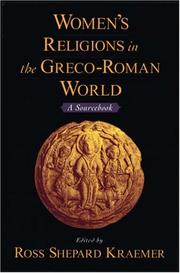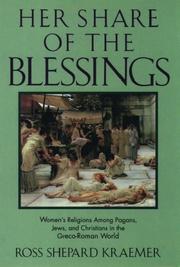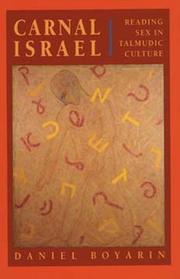| Listing 1 - 10 of 17 | << page >> |
Sort by
|
Periodical
Year: 1997 Publisher: Toronto : [Thornhill, Ont.] : [University of Toronto], Dept. of Near & Middle Eastern Civilizations, Women in Judaism, Inc.
Abstract | Keywords | Export | Availability | Bookmark
 Loading...
Loading...Choose an application
- Reference Manager
- EndNote
- RefWorks (Direct export to RefWorks)
Women in Judaism --- Jewish women --- Women in Judaism. --- Jewish women.
Periodical
Year: 1998 Publisher: New York, NY : The Alliance,
Abstract | Keywords | Export | Availability | Bookmark
 Loading...
Loading...Choose an application
- Reference Manager
- EndNote
- RefWorks (Direct export to RefWorks)
Jewish women --- Women in Judaism --- Orthodox Judaism --- Feminism --- Orthodox Judaism. --- Women in Judaism. --- Religious life --- Religious aspects --- Judaism --- Judaism. --- Religious life.

ISBN: 9004117474 9004500936 Year: 2000 Volume: 26 Publisher: Boston ; Leiden ; Köln Brill
Abstract | Keywords | Export | Availability | Bookmark
 Loading...
Loading...Choose an application
- Reference Manager
- EndNote
- RefWorks (Direct export to RefWorks)
Femmes dans le judaïsme --- Vrouwen in het jodendom --- Women in Judaism --- Women --- Legal status, laws, etc. (Jewish law) --- Jewish women --- Palestine --- Social conditions --- 16th century --- Syria --- Egypt

ISBN: 0814327133 Year: 1999 Publisher: Detroit Wayne State University Press
Abstract | Keywords | Export | Availability | Bookmark
 Loading...
Loading...Choose an application
- Reference Manager
- EndNote
- RefWorks (Direct export to RefWorks)
De laatste jaren is het debat over de status van vrouwen in het hedendaagse Jodendom gegroeid. Het seculiere Westerse leven biedt vrouwen grotere kansen op educatief gebied en in het beroepsleven en de maatschappij onderschrijft de gelijkheid van mannen en vrouwen. Hierdoor is de ontevredenheid over de traditionele Joodse grenzen van vrouwelijke participatie in religieuze, academische en maatschappelijke activiteiten gegroeid. Hoewel er vele hedendaagse antwoorden zijn op de traditionele Joodse idee van de rol van de vrouw, ontbreken er in de discussie perspectieven vanuit het verleden. Dit boek wil een dergelijke historische excursie bieden. Elk essay biedt een overzicht van de periode in kwestie en stelt vragen rond de algemene situatie van Joodse vrouwen en hun activiteiten in het door mannen gedomineerde publieke en intellectuele leven, als ook in een grotere niet-Joodse culturele omgeving. De beeldvorming van Joodse vrouwen in de verschillende periodes komt eveneens aan bod.
History --- Jewish religion --- Sociology of the family. Sociology of sexuality --- Jewish women --- Women in Judaism. --- Religious life. --- History. --- Gender --- Religious texts --- International --- Judaism --- Images of women --- Book
Book
ISBN: 1951498089 1946527742 1951498070 9781951498085 9781951498078 9781946527745 Year: 2020 Publisher: Brown Judaic Studies
Abstract | Keywords | Export | Availability | Bookmark
 Loading...
Loading...Choose an application
- Reference Manager
- EndNote
- RefWorks (Direct export to RefWorks)
This book argues that women served as leaders in a number of synagogues during the Roman and Byzantine periods. The evidence for this consists of nineteen Greek and Latin inscriptions in which women bear the titles "head of the synagogue," "leader," "elder," "mother of the synagogue" and "priestess." These inscriptions range in date from 27 B.C.E. to perhaps the sixth century C.E. and in provenance from Italy to Asia Minor, Egypt and Palestine. While new discoveries make this a growing corpus of material, a number of the inscriptions have been known to scholars for some time. The book contains a new preface by the author.
Religion. --- Religion, Primitive --- Atheism --- Irreligion --- Religions --- Theology --- Judaism --- Women in Judaism --- Synagogues --- Jews --- History. --- Organization and administration --- History --- Jewish architecture --- Religious institutions --- Temples

ISBN: 155540765X Year: 1992 Volume: vol 59 Publisher: Atlanta, Ga. Scholars Press
Abstract | Keywords | Export | Availability | Bookmark
 Loading...
Loading...Choose an application
- Reference Manager
- EndNote
- RefWorks (Direct export to RefWorks)
Femmes dans le judaïsme --- Vrouwen in het jodendom --- Women in Judaism --- 396.7 --- Jewish women --- -Jewish women --- -Women, Jewish --- Women --- Judaism --- Vrouw en religie --- History --- Religious life --- -Vrouw en religie --- 396.7 Vrouw en religie --- -396.7 Vrouw en religie --- Women, Jewish --- Women [Jewish ] --- Women in Judaism. --- Women, Jewish - History. --- Women, Jewish - Religious life.

ISBN: 0195142780 0195170652 9780195142785 Year: 2004 Publisher: Oxford: Oxford university press,
Abstract | Keywords | Export | Availability | Bookmark
 Loading...
Loading...Choose an application
- Reference Manager
- EndNote
- RefWorks (Direct export to RefWorks)
Women and religion --- Women in Judaism --- Women in Christianity --- Women --- History --- Religious life --- #GGSB: Religie (alg. - niet chr.) --- 292 --- Godsdiensten van Grieken en Romeinen. Klassieke mythologie --- Religie (alg. - niet chr.) --- Women and religion - History - Sources. --- Women in Judaism - History - Sources. --- Women in Christianity - History - Early church, ca.30-600 - Sources. --- Women - Religious life - Rome - History - Sources. --- Women - Religious life - Greece - History - Sources.

ISBN: 0195086708 0195066863 9780195066869 9780195086706 Year: 1994 Publisher: New York Oxford University Press
Abstract | Keywords | Export | Availability | Bookmark
 Loading...
Loading...Choose an application
- Reference Manager
- EndNote
- RefWorks (Direct export to RefWorks)
Ross Shepard Kraemer vividly recreates the religious lives of early Christian, Jewish, and pagan women, with many fascinating examples (...). The relationship among female autonomy, sexuality, and religion emerges as a persistent theme. Analyzing the monastic Jewish Therapeutae and various Christian communities, Kraemer demonstrates the paradoxical liberation which women achieved by rejection of sexuality, the body, and the female. In the epilogue, Kraemer pursues the disturbing implications such findings have for contemporary women. [publisher's description]
Women in Judaism --- Femmes dans le christianisme --- Femmes dans le judaïsme --- Geschichte (30-500) --- Mittelmeerraum --- Mediterranean region. --- Paganism --- Women and religion --- Women in Christianity --- Women --- History. --- History --- Religious life --- Mittelmeerraum. --- Mediterranean region --- Primitive and early church, ca. 30-600 A.D. --- Women - Mediterranean Region - Religious life - History. --- Women and religion - History. --- Women in Judaism - History. --- Women in Christianity - History - Early church, ca. 30-600.

ISBN: 0585138818 052091712X 9780520917125 9780585138817 0520080122 0520203364 Year: 1995 Publisher: Berkeley, Calif. University of California Press
Abstract | Keywords | Export | Availability | Bookmark
 Loading...
Loading...Choose an application
- Reference Manager
- EndNote
- RefWorks (Direct export to RefWorks)
Beginning with a startling endorsement of the patristic view of Judaism-that it was a "carnal" religion, in contrast to the spiritual vision of the Church-Daniel Boyarin argues that rabbinic Judaism was based on a set of assumptions about the human body that were profoundly different from those of Christianity. The body-specifically, the sexualized body-could not be renounced, for the Rabbis believed as a religious principle in the generation of offspring and hence in intercourse sanctioned by marriage.This belief bound men and women together and made impossible the various modes of gender separation practiced by early Christians. The commitment to coupling did not imply a resolution of the unequal distribution of power that characterized relations between the sexes in all late-antique societies. But Boyarin argues strenuously that the male construction and treatment of women in rabbinic Judaism did not rest on a loathing of the female body. Thus, without ignoring the currents of sexual domination that course through the Talmudic texts, Boyarin insists that the rabbinic account of human sexuality, different from that of the Hellenistic Judaisms and Pauline Christianity, has something important and empowering to teach us today.
Sex in rabbinical literature. --- Human body in rabbinical literature. --- Women in rabbinical literature. --- Rabbinical literature --- Sex --- Human body --- Women in Judaism. --- Judaism --- History and criticism. --- Religious aspects --- Judaism. --- History --- Women in the Talmud --- Body, Human, in rabbinical literature --- Women in judaism --- Religion --- Literary criticism --- Talmudic period, 10-425.
Book
ISSN: 07218753 ISBN: 3161462831 9783161462832 Year: 1995 Volume: 44 Publisher: Tübingen: Mohr,
Abstract | Keywords | Export | Availability | Bookmark
 Loading...
Loading...Choose an application
- Reference Manager
- EndNote
- RefWorks (Direct export to RefWorks)
Jewish women --- Jews --- History --- Judaism --- Women in Judaism --- Women in rabbinical literature --- Women in the Talmud --- Rabbinical literature --- Hellenistic Judaism --- Judaism, Hellenistic --- Women, Jewish --- Women --- Jewish women - Palestine - History --- Jews - Palestine - History - 586 B.C.-70 A.D
| Listing 1 - 10 of 17 | << page >> |
Sort by
|

 Search
Search Feedback
Feedback About UniCat
About UniCat  Help
Help News
News